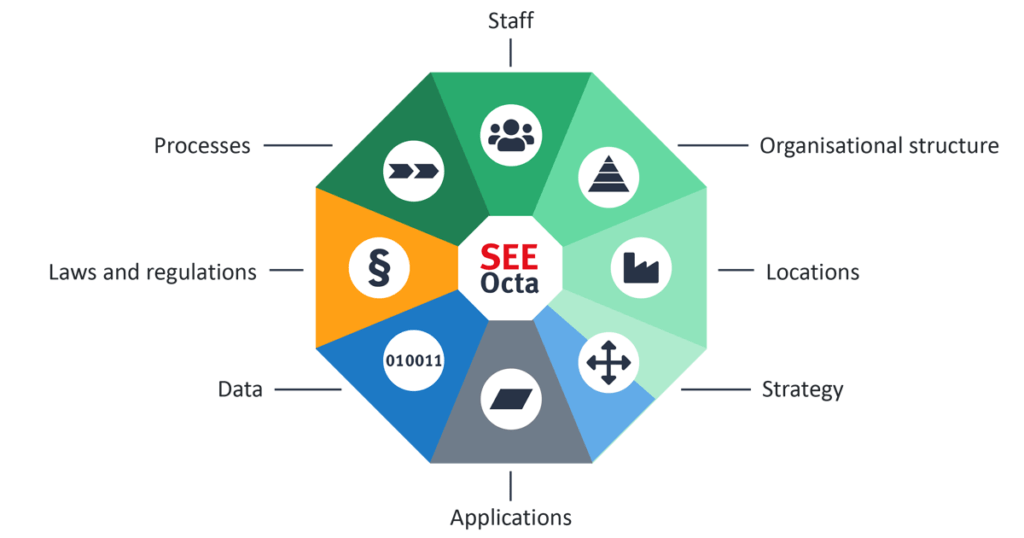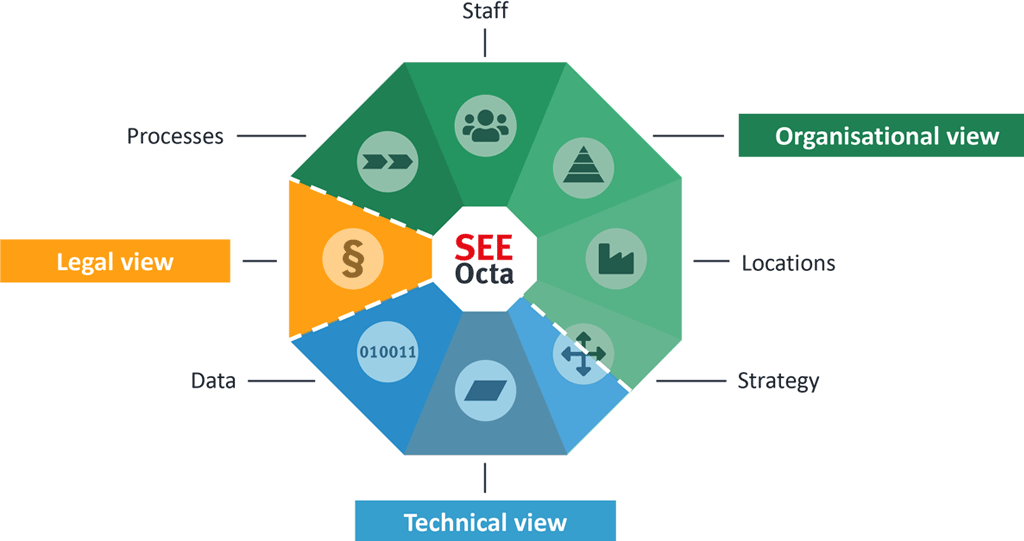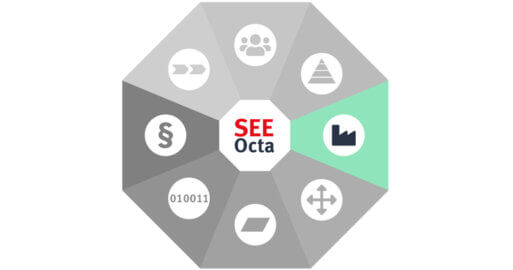SEEOcta – Eight Perspectives

SEEBURGER recommends the consideration of a holistic approach in the implementation of IT projects (here exemplary for e-invoice inbound projects): the SEEOcta. In a multi-part blog series, we will present all views and perspectives of our consulting approach. Read on to discover what this is all about.
The SEEOcta blog series highlights the eight most important perspectives for successful project management. Discover all the areas you need to consider when planning digitalization and integration projects in your company. Armed with the ideas and knowledge in the articles, you will have a solid foundation for planning your IT project and a guide to help you ensure that no one gets left behind.
What is SEEOcta?
SEEOcta represents a holistic consulting approach for project leaders and managers of a company that wants to introduce IT systems as part of a project.Through looking at the whole picture, SEEOcta makes complex structures visible. Implementing an IT project can, for many companies, be a very complex undertaking which involves considerably more than just introducing new processes or software. In order to achieve significant, effective change, your company needs to be scrutinized from various angles.
The SEEOcta series considers the changes in your company triggered by the start of an IT project from eight different perspectives. These have been grouped into three higher-level categories – views – of organisational, technical and legal considerations. We at SEEBURGER are convinced that corporate change processes can only be successful if each of these eight perspectives are given due consideration. Figure 1 shows the eight perspectives of the SEEOcta:

At the start of a project, it is important to work out how and to what extent the desired business transformation could be positively or negatively affected by each of the eight perspectives. What has to change and what shouldn’t be changed in order to achieve our goals? These questions are foundation stones for successful project management.
The eight perspectives in SEEOcta
The SEEOcta perspectives consider the following aspects:
- Processes
The work processes in a company are analysed in order to understand what steps need to be done, when, how and by whom. What rules and regulations need to be taken into account, in what order do these steps need to be done, and why are they necessary? - Staff
We need to look at the following questions:- Are employees in roles which fit their business and social skills?
- Does training need to be offered for this change?
- Will this business change affect skill and task areas?
- Do employees see this change positively or negatively? What is likely to be accepted, and what resisted?
- Organisational structure
Company culture, organisational structure (hierarchy, business units departmental and team structures), organisational knowledge, skills and potential. - Locations
Headquarters, branches, subsidiaries, data centres, profit centres, etc. - Strategy
Company and IT strategy (hardware and software employed, communications infrastructure) and interoperability. - Applications
Including the following questions:- What applications are being used in the company?
- Are these the ʽrightʼ applications for their needs?
- Are there enough licences?
- Can interoperability be assured?
- Do these support business processes, are there enough employees assigned to these?
- Is there a need for software training?
- To what extent can certain software support the change process?
- Data
Here, data is analysed for content, structure and format. Any processing steps required are also highlighted to ensure interoperability between applications, to comply with specified business processes or to make data visible and editable for users. - Laws and regulations
What laws and regulations need to be taken into consideration? Are other locations governed by a different legal framework? Do technology and processes comply with these legal stipulations?
Processes and (IT) strategy are key factors in successfully implementing a project. Changes in these two variables often require change in the remaining SEEOcta perspectives, laws and regulations excepted.
SEEOcta’s three views
Organisational, technical and legal views in IT projects
These individual SEEOcta perspectives can be grouped into three higher-level categories – views. For example, the perspectives processes, staff, organisational structure and locations look at the change process through an organisational lens, while applications and data are technical project considerations. A special place is occupied by the perspective strategy. As this considers both business and IT strategy, it happily straddles both the organisational and technical categories. This leaves us with the legal view, made up of laws and regulations, to keep our eye on the current and potential legal situation.

While organisational and technical decisions can be actively shaped by a company, the same is not true for legal stipulations. Nevertheless, it’s important to know what it going on in the legal world as decisions taken by the lawmakers can lead to significant changes being required in the corporate world. Examples here include tax laws and data protection laws.
Considering all three views is an important extension to independently considering the individual perspectives inherent in IT project management. This ensures that actors are aware of the need to integrate and coordinate between the various perspectives and can plan this accordingly.
Successful project management then takes a second step and tests how the three views are dependent upon each other and influence each other. This then allows you to work out what needs to be integrated and coordinated between these areas.
In this comprehensive SEEOcta blog series, you can discover how you can employ the eight perspectives and three views in your projects. Part one in this series looks at employee communication. How can you motivate your employees to actively contribute to the success of an IT project? Find out here!
This post is part of the SEEOcta series. Look at our blog category SEEOcta and use the search term SEEOcta to find further interesting posts on launching a new IT project.
Thank you for your message
We appreciate your interest in SEEBURGER
Get in contact with us:
Please enter details about your project in the message section so we can direct your inquiry to the right consultant.
Written by: Rolf Holicki
Rolf Holicki, Director BU E-Invoicing, SAP&Web Process, is responsible for the SAP/WEB applications and digitization expert. He has more than 25 years of experience in e-invoicing, SAP, Workflow and business process automation. Rolf Holicki has been with SEEBURGER since 2005.



